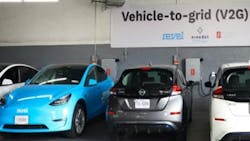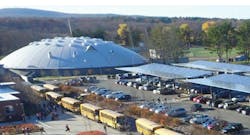NYC Vehicle-to-Grid Pilot Shows How EVs – as Mobile Microgrids – Can Earn Income for Drivers and Fleets
Three bidirectional Nissan Leaf electric vehicles (EV) – serving as mobile microgrids exporting energy to Consolidated Edison (ConEd) – demonstrated in a pilot project that it’s possible for EV drivers to earn income under New York’s innovative Value of Distributed Energy Resources (VDER) program, one of the project partners said.
In addition, the project found that it’s generally easier to site EVs in New York City than it is to site stationary storage for the VDER program.
The pilot is a partnership between clean energy project developer NineDot Energy, Fermata Energy, which provides hardware and software to send signals to the EVs, and the electric mobility company Revel. Another partner is the National Renewable Energy Laboratory (NREL), which developed a program to help identify the best times and locations to send energy from EVs to the grid.
More utilities and car manufacturers testing bidirectional EVs
Increasingly, bidirectional EVs are seen as key to aiding the energy transition by providing backup resources, income-generating opportunities and grid assets. Recently, Toyota and San Diego Gas & Electric announced a project to identify ideal experiences for residential vehicle-to-grid exports.
“Utilities and vehicle original equipment manufacturers across the U.S. and Europe are actively pursuing demonstration deployments to fine-tune their understanding of how the bidirectional charging technology works, what’s possible with the technology and what’s the best way to structure the regulatory solutions that will liberate the benefits of bidirectional charging,” said David Slutzky, founder and chairman of the board of Fermata Energy.
EV Charging Infrastructure Perfect for Microgrids
Learn more at Microgrid 2024 this April in Baltimore
New York state’s VDER program is attractive to EV drivers and fleets because it offers a number of ways to reap income in the market. The program pays for five different services and, in some cases, DER and EV owners can “stack” or provide more than one grid service, which boosts revenues to DER and EV owners while supporting the grid.
Pilot yields 60 days of energy exports and income
The partners began the pilot – funded through the Wells Fargo Innovation Incubator, a clean tech program supported by Wells Fargo and NREL – partway through the summer of 2022. During the summer of 2023, the pilot yielded 60 days of energy exports from the EVs, said Joe Silver, product manager at NineDot Energy. The site host was Revel, which installed chargers in Brooklyn for the project.
“The project reiterated what we had proven: that vehicle-to-grid is eligible for credits in New York,” Silver said.
New York’s VDER program provides numerous revenue streams
The effort took advantage of three of five possible revenue streams under the VDER program, he said. The most lucrative was the demand reduction value. During about 60 summer days, ConEd compensated the project for exporting energy to the grid between 2 p.m. and 6 p.m. on nonholiday weekdays.
“It’s a fixed value contract for 10 years when you’re interconnected,” Silver said. Because it’s a fixed rate, it helps projects get financed, he added.
Another value stream was locational marginal-based pricing, which is the value of energy exports when and where they’re provided.
A third revenue stream under the VDER program is capacity value of the project, based on the statewide peak hour of the year.
In order to receive that compensation, NineDot Energy used weather forecasts to help predict when the peak hour would occur, Silver said. ConEd doesn’t identify that peak hour, but it generally happens during the summer.
Working through the pilot project’s bugs
During the summer of 2022, NineDot grappled with a few challenges, Silver said. “We had to get the scheduling right. We had to understand the difference between the rated capacity of the EV battery and what’s actually usable.”
The Nissan Leafs had 62-kWh batteries and were charged with 15-kW chargers. “You’d think you’d get a four-hour discharge, but, in practice, the cars don’t like to discharge down to zero and the batteries aren’t always at 100%,” he said. They often lose some charge standing idle overnight.
Once the partners addressed those challenges, the project confirmed NineDot Energy’s expectations.
Easier to permit bidirectional EVs than stationary storage
“We found that three Nissan Leafs can provide three hours of exports using 15-kW Fermata bidirectional chargers,” said Silver. “You can install, interconnect and operate EV chargers in New York City and do it faster than large stationary batteries,” he added. It’s easier to permit EVs than stationary batteries because the EVs aren’t regulated by the fire department.
NineDot Energy will continue to test other bidirectional EVs at the New York City site as they become available, Silver said.
New York City is an ideal place to test the vehicles because the export revenues are higher in the city than in many other markets. ConEd has a high peak load in the summer that needs to be balanced with resources such as EVs and stationary storage. In addition, storage will be needed to help support the grid as electrification accelerates, increasing demand on the grid, said Silver.
Meanwhile, Fermata Energy is designing rate programs with utilities and regulators that will allow Fermata to respond with bidirectional charging in real time if utilities are experiencing peak loads and constrained circuits, said Slutzky.
NREL developing program that helps identify when to export to the grid
And NREL continues to work on an as-yet-unnamed program that estimates the impact of exporting EV battery power to the grid. The program focuses on how much power to inject into the grid – and when – to maximize revenues, said NREL senior power systems engineering researcher Harsha Vardhana Padullaparti.
For now, the prospects of using bidirectional EV fleets to support the New York City grid and earn income look promising.
“We’ve shown that you can safely install, interconnect and operate bidirectional EV chargers in a dense urban place and can monetize them using existing tariffs,” said Silver. “We’re excited to scale this up.”








